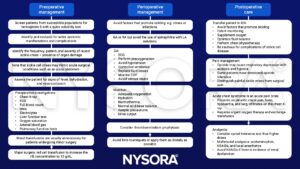Learning objectives
- Sings and symptoms and management of sickle cell disease
Definition and mechanisms
- Sickle cell disease is a group of inherited hemoglobinopathies
- The most common type is known as sickle cell anemia, other types are sickle cell anemia (HbSS) and the double heterozygote conditions sickle C (HbSC) and sickle thalassemia (HbSThal)
- The average life expectancy is 40 to 60 years
- The dominant hemoglobin (Hb) is replaced by the unstable hemoglobin S resulting in the deformation of the red cell membrane into the characteristic sickle shape
- These sickle cells become rigid and aggregate, thereby occluding small blood vessels and leading to tissue infarction
- Hemolysis occurs due to the damaged cell membrane leading to an inflammatory response
- The major features of sickle cell disease are chronic anemia and the occurrence of sickle cell ‘crises’ in which multiple episodes of tissue infarction occur
- Crises can be provoked by temperature changes, stress, dehydration, and high altitude
Signs and symptoms
- Symptoms of sickle cell anemia usually appear around 6 months of age
- Vary from person to person and may change over time
- Anemia
- Episodes of pain
- Swelling of hands and feet
- Frequent infections
- Delayed growth or puberty
- Vision problems
Complications
- Stroke
- LV hypertrophy
- High-output cardiac failure (anemia)
- Myocardial infarction without coronary artery disease
- Acute chest syndrome
- Pulmonary hypertension
- RV hypertrophy
- Cor-pulmonale
- Renal failure or infarction
- Splenic sequestration
- Blindness
- Leg ulcers
- Gallstones
- Priapism
- Deep vein thrombosis
- Pregnancy complications
- Acute pain crisis
Management
- Avoid precipitants of sickle cell crisis
- Hypoxia
- Vascular stasis
- Hypothermia
- Hypovolemia/hypotension
- Acidosis

Suggested reading
- Pollard BJ, Kitchen, G. Handbook of Clinical Anaesthesia. Fourth Edition. CRC Press. 2018. 978-1-4987-6289-2.
- Wilson, M., Forsyth, P., Whiteside, J.. Haemoglobinopathy and sickle cell disease. Continuing Education in Anaesthesia Critical Care & Pain. 2010. 10, 24–28.
We would love to hear from you. If you should detect any errors, email us customerservice@nysora.com








